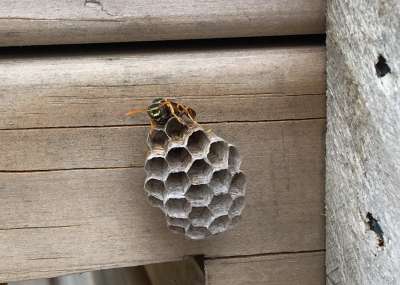Paper Wasps
The black and yellow striped Asian paper wasp Polistes chinensis, arrived in New Zealand in the late 1970s. They settled into the suburbs of Auckland and are now responsible for most wasp stings that result in visits to the doctor. More recently the European paper wasp has been found in New Zealand, first identifications were in the upper North Island. It is very similar looking to the Asian species. The Australian (sometimes called the Tasmanian) paper wasp Polistes tasmaniensis humilis, resembles the Asian and European paper wasps in shape but it is black and red-brown, with yellowish legs (see above). It has been part of the bush and garden scene of northern New Zealand for over 100 years. The paper wasps have a more obvious narrow waist than the German and common wasps and longer narrower bodies.

Asian Paper Wasp Nest
The Asian, Australian and European Paper Wasps form much smaller colonies than the common or German wasps. Their nests will have only a few tens of cells in an open type nest. The Paper Wasps are consequently less of a direct threat to people as although, single stings from them are common, you are unlikely to get the very many stings that you can suffer from disturbing a German or common wasp nest containing many thousands of wasps. However, paper wasps are a threat to native insect species such as Monarch Butterflies on which they feed. Many people will wish to control the paper wasps to protect their Monarchs and other beneficial insects.
Recently there have been more and more reports of sightings of these species further and further south in New Zealand and sightings are very early this Spring (2020). So be on the lookout for these insects and if necessary, you can destroy the nest with NO Wasps Nest Killer Aerosol. They produce small open nests on branches or under eaves and the aerosol will fire a stream of ‘freezing’ fast acting insecticide from a safe distance of 4 metres.
David Brittain
Kiwicare

